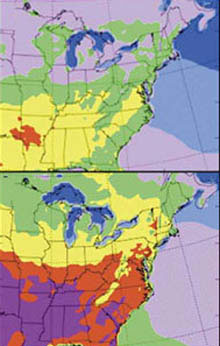Global warming to cause summer temperature spike in Eastern U.S.
Global warming to cause summer temperature spike in Eastern U.S.
mongabay.com
May 11, 2007
NASA scientists warn that average summer temperatures in the eastern United States will climb as much as 10 degrees Fahrenheit by the 2080s as a result of human-induced global warming.
The study’s climate model projects higher temperatures in the region than those forecast by global models used by the Intergovernmental Panel on Climate Change (IPCC), which showed temperatures rising between two and 3.5 degrees C for the region by 2100.
NASA says the difference is due to how its model accounts for variation in rainfall for the region.
“There is the potential for extremely hot summertime temperatures in the future, especially during summers with less-than-average frequent rainfall,” said lead author Barry Lynn of NASA’s Goddard Institute for Space Studies and Columbia University, New York.

A computer model projection of average daily maximum temperatures over the eastern United States for July 2085 (bottom) and July 1993 (top). Areas in violet shading show temperatures of 26C (79F); green 30C (86F); yellow 34C (93F); red 38C (100F); dark purple 42C (108F). |
The research, published in Journal of Climate, suggests that in “extreme seasons — when precipitation falls infrequently — July and August daily high temperatures could average between 100 and 110 degrees Fahrenheit in cities such as Chicago, Washington, and Atlanta.”
The study, based on three decades of observational temperature and precipitation data, used computer model simulations factored in expected soil, atmospheric, and oceanic conditions and projected 2 percent annual rise in greenhouse gases. The authors say their model is more accurate than global models used by the Intergovernmental Panel on Climate Change (IPCC).
2006 was the third warmest year on record for the United States, just cooler than 1998 and 1934, while the 2006-2007 winter was the warmest ever.
Last month researchers at Columbia University’s Lamont Doherty Earth Observatory warned that climate change could turn the American southwest into a “Dustbowl.”